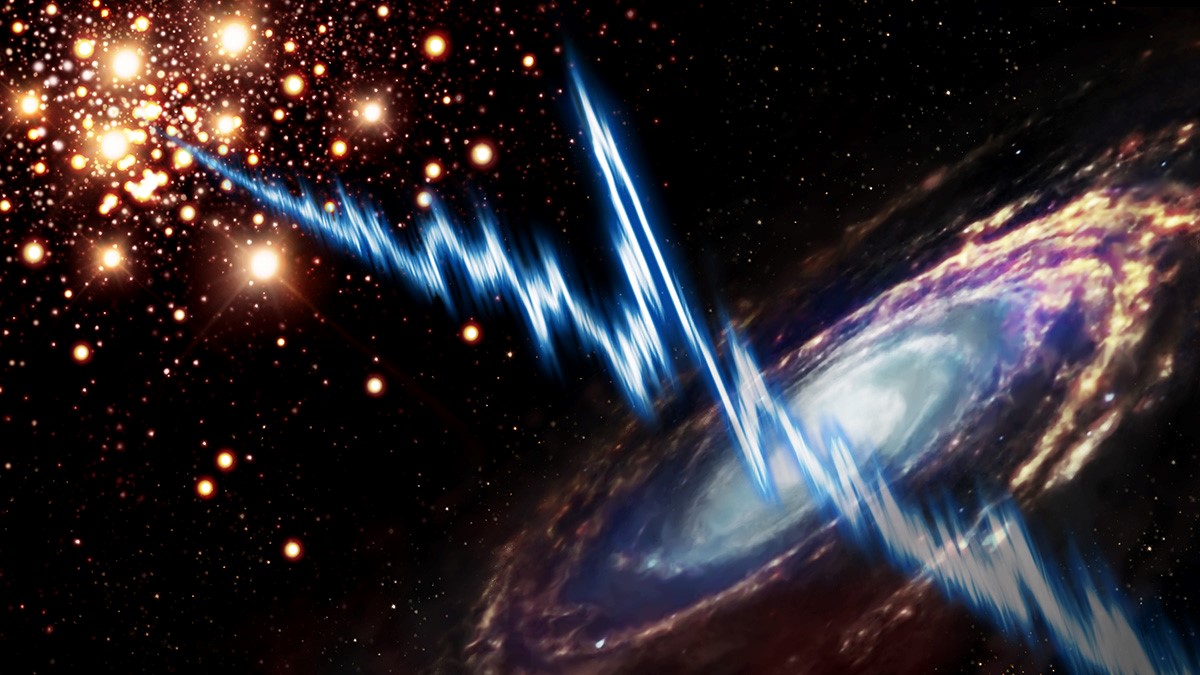Fast radio bursts are millisecond-duration, extremely bright flashes of radio light that reach us from other galaxies. We do not know what they are but compelling evidence suggests that they are generated by young stars called magnetars. We found such an object in a globular cluster, an environment where one would absolutely not expect a magnetar. How did this fast radio burst get there?
Views 3001
Reading time 4 min
published on May 17, 2023
In 2007, Duncan Lorimer and his colleagues announced the discovery of a flash of radio light that was not only extremely short and bright but that also seemed to be coming from a galaxy far away from our own. At the time, the astronomical community was very skeptical about the celestial nature of the source and wondered if it had been generated on Earth. The discovery of another four such bursts in 2013 unambiguously proved their cosmological origin. This also marked the beginning of the exciting and fast advancing field of fast radio burst (FRB) research in modern astrophysics.
Today, we have discovered more than 600 such flashes, the vast majority of which have only ever been seen once. A small fraction, however, is bursting repeatedly, the so-called repeating FRBs. All FRBs, repeating or not, are extremely short: they last for only a few milliseconds. Within that time, they emit as much energy as the Sun does in an entire day! We are still unsure what type of object generates these bursts, let alone how.
One key aspect needed to understand the nature of FRBs is what type of galaxies they are emitted from and, more specifically, what environment they reside in: do they live in old elliptical galaxies or are they hosted in regions where stars are born? The answer to this question gives us some clues about the possible type of stars that generate FRBs. The trouble is that it is hard to measure the location of an FRB precisely enough to pinpoint it to a region within a certain galaxy – especially if it only flashes once. This is where the repeating FRBs become so interesting: they offer us an opportunity to observe the region of the sky where the source was seen repeatedly with an array of different telescopes spread across the globe. When combining the data from the various dishes that all observe the same patch of sky simultaneously, we can make an image sharp enough to tell where inside a certain galaxy a particular FRBs originates from. In this way we have traced FRBs back to very diverse regions which hint at magnetars as the stars that generate FRBs. Magnetars are objects with extremely strong magnetic fields that are typically found in regions where massive stars live fast and die young. They are the leftovers of supernovae and are well-known for generating bright flashes in our own Milky Way Galaxy – but only for several 10000 years after their birth.
One of the latest additions to the collection of repeating FRBs is FRB20200120E. The first rough estimate placed this object right in our backyard, in the vicinity of the grand design spiral galaxy M81. We activated our array of telescopes – including the 100-meter telescope in Effelsberg, Germany – and, lo-and-behold! We saw not one but five bursts from this source over the course of 3 months. To our great surprise, the position that we measured placed the origin of the flashes right on top of a globular cluster that is part of M81. Globular clusters are collections of millions of stars that are very old, so old that all the massive stars that would have left behind a magnetar died billions of years ago. By now, any magnetar formed in that process would have lost the energy to generate bright flashes. So, what could possibly be the source of the emission?
This is where the speculation starts. As it turns out, one can also create a magnetar via accretion-induced collapse of a white dwarf; a process in which matter from a second star falls onto the white dwarf that then collapses under its own weight thanks to gravity. The large number of white dwarfs and binary systems – two stars orbiting each other – in globular clusters makes such a scenario possible. Alternatives include millisecond pulsars or low-mass X-ray binaries which are all compact objects seen in abundance in globular clusters.
Whatever the emitting source might be, the mere fact that this FRB is so close (M81 is “just” a distance of 3.6 Mpc away; in comparison, the next closest FRB is 40 times farther) makes it an ideal target for multi-wavelength follow-up. At this point, we have not yet seen an extragalactic FRB with optical or X-ray telescopes and this source is our best shot yet. Seeing a flash across the electromagnetic spectrum, i.e. from radio frequencies, through optical light and all the way to X-rays, will bring us a huge step closer to understanding the origin of FRBs.
Original Article:
Kirsten, F., Marcote, B., Nimmo, K., Hessels, J. W. T., Bhardwaj, M., Tendulkar, S. P., Keimpema, A., Yang, J., Snelders, M. P., Scholz, P., Pearlman, A. B., Law, C. J., Peters, W. M., Giroletti, M., Paragi, Z., Bassa, C., Hewitt, D. M., Bach, U., Bezrukovs, V., … Vlemmings, W. (2022). A repeating fast radio burst source in a globular cluster. Nature, 602(7898), 585–589. https://doi.org/10.1038/s41586-021-04354-w
 Earth & Space
Earth & Space



